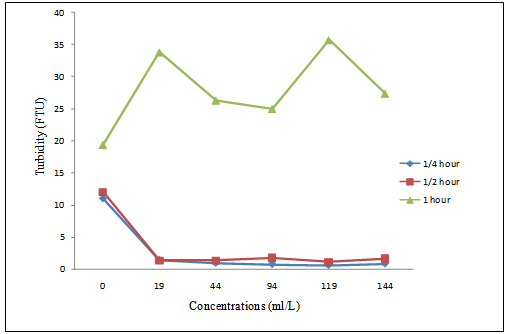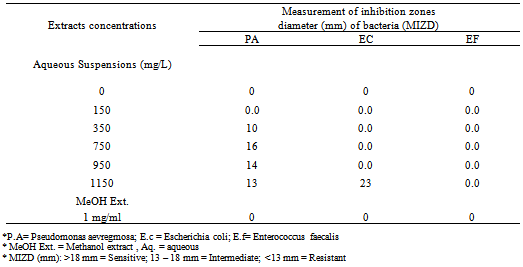-
Paper Information
- Next Paper
- Previous Paper
- Paper Submission
-
Journal Information
- About This Journal
- Editorial Board
- Current Issue
- Archive
- Author Guidelines
- Contact Us
Journal of Microbiology Research
p-ISSN: 2166-5885 e-ISSN: 2166-5931
2013; 3(5): 171-175
doi:10.5923/j.microbiology.20130305.02
Utilization of Moringa oleifera Seeds in Purification of Tap Water in Khartoum State, Sudan
Nahla N. Yousif1, Hassan B. Elamin1, Hiba A. Ali1, Abdel Moneim E. Sulieman2
1Commission for Biotechnology & Genetic Engineering, National Centre for Research, Ministry of Science and Technology, Khartoum, Sudan
2Department of Biology, Faculty of Science, University of Hail, Hail, Kingdom of Saudi Arabia
Correspondence to: Abdel Moneim E. Sulieman, Department of Biology, Faculty of Science, University of Hail, Hail, Kingdom of Saudi Arabia.
| Email: |  |
Copyright © 2012 Scientific & Academic Publishing. All Rights Reserved.
This study gives an overview of the application of an indigenous, naturally derived coagulant obtained from seeds of the multi-purpose tree M. oleifera in Khartoum province tap water. M. oleifera seeds kernels were crushed and a stock solution was prepared using distilled water. Different concentrations (150, 350, 750, 950, 1150 mg/L) were prepared from this stock solution to be used as coagulants at different time intervals. The seeds kernels were also extracted using 80% methanol. Antibacterial effects of aqueous and methanol extracts were tested against Pseudomonas aeruginosa, Escherichia coli and Entrococcus faecalis.Pseudomonas aeruginosa bacteria which showed sensitivity towards four concentrations of M. oleifera seeds suspensions, three of which were significant[750 mg/L (16 mm), 950 mg/L (14 mm), 1150 mg/L (13 mm)]. E. coli was inhibited significantly at 1150 mg/L (23 mm). Entrococcus faecalis was not inhibited by none of the concentrations. M. oleifera seeds methanolic extract was not active against any of the tested bacteria at the concentration of 1 mg/ml. Seeds of M. oleifera reduced tap water turbidity in the range of 87 – 95 % at different concentrations after 15 minutes. Turbidity of tap water tested was best reduced up to 0.6 FTU (95 %) after 15 minutes application of M. oleifera seeds suspension at the concentration of 950 mg/L.
Keywords: Moringa, Antibacterial Effects, Methanol Extracts, Turbidity
Cite this paper: Nahla N. Yousif, Hassan B. Elamin, Hiba A. Ali, Abdel Moneim E. Sulieman, Utilization of Moringa oleifera Seeds in Purification of Tap Water in Khartoum State, Sudan, Journal of Microbiology Research, Vol. 3 No. 5, 2013, pp. 171-175. doi: 10.5923/j.microbiology.20130305.02.
Article Outline
1. Introduction
- Moringa oleifera Lam. (Moringa) is the most widely cultivated species of a monogeneric family, the Moringaceae [1]. It is a tree native to India and cultivated in all sub-tropical areas. This tropical multipurpose fast growing tree is resistant to drought. Moringa is naturalized in Tanzania, Nicaragua, Malawi, Brazil, Niger, Indonesia and Senegal (Optima of Africa, Ltd.) In Sudan, Jahn and Dirar[2] reported That ground seed powder has traditionally been used for the clarification of turbid drinking water in rural area of Sudan.Currently drinking water sanitary practices depends on a number of chemical compounds, such as chlorine, fluoride, ozone and polyacrymides used as disinfection and/or coagulant agents[3]. Beside the economic and environmental drawback, chemical water treatment such as metal salts, synthetic polymers, chlorine formulation have negative impact on human health[4] The use of natural materials of plant origin to clarify turbid water is not a new idea For example, Fashey[5] reported that specific components of Moringa preparations that have been reported to have hypotensive, anticancer, and antibacterial activity include 4-(4'-O-acetyl-a-L-rhamnopyranosyloxy) benzyl isothiocyanate[1], 4-(a-L-rhamnopyranosyloxy) benzyl isothiocyanate[2], niazimicin[3], pterygospermin[4], benzyl isothiocyanate[5], and 4-(a-L-rhamnopyranosyloxy) benzyl glucosinolate[6]. Among all the plant materials that have been tested over the years, the seeds from M. oleifera have been shown to be one of the most effective as a primary coagulant for water treatment and can be compared to those as of alum (conventional chemical coagulant). Moringa has a direct impact on health nutrition, agriculture, water, sanitation, biodiversity and environment. There is an interest from entrepreneurs for the miracle tree because all its parts are used for nutritional and pharmacological properties but also to purify and clear water Fuglie[6]. This tree has in recent times been advocated as an outstanding indigenous source of highly digestible protein, Ca, Fe, Vitamin C and carotenoids suitable for utilization in many of the so called “developing” regions of the world where undernourishment is a major concern. M. oleifera seeds contain high quality edible oil (up to 40% by weight) and water soluble proteins that act as effective coagulants for water and wastewater treatment.Water purification and reduction of water borne diseases is a major public health goal and is the main objective of this study. In the present study M. oleifera seeds was used in direct filtration of tap water in Khartoum and evaluated for their efficiency in removing turbidity and microorganisms from water. The study was laboratory based using an actual tap water.
2. Materials and Methods
2.1. Preparation of Moringa oleifera Seed Suspensions and Extracts
- Moringa oleifera seeds used were collected from the faculty of Agriculture University of Khartoum, 2009. The seed wings were removed and the kernels were ground to a fine powder using domestic food blender. Two grams (2g) of the seeds powder were extracted using 200ml distilled water by blending for 30s. The resulting suspension was filtered through a muslin cloth and the filtrate was made up to (500ml) to give a stock solution of approx (4000mg/L). The solution was always prepared fresh for use and when needed, since deterioration sets in if stored for more than two day at room temperature. Different concentrations were prepared according to Muyibi and Evison[7] (Table 1) from this stock solution and were used for antibacterial and turbidity assessments. Fifteen g of air dried course ground seeds of M. oleifera were extracted by using 80% methanol. Extract was obtained by removing the solvent using rotary evaporation. Extract obtained was subjected to further biological assay.
|
2.2. Treated Water
- Water treated was obtained from the Commission for Biotechnology and Genetic Engineering, National Center for Research, Khartoum tap water source.
2.3. Testing for the Antibacterial Activity
- Agar diffusion method was performed following Kavangh (1972)[8] with some modifications was used for Testing for the antibacterial activity of Moringa. 0.2 ml of the standardized bacterial stock suspension were mixed with 20 ml of sterile nutrient agar and poured into sterile Petri dish, the agar left at room temperature to dry. 4 cups (10 mm in diameter) were cut using cork borer and agar discs were removed. Cups were filled with 0.1 ml of the different Moringa seeds extract concentrations in a separate petri dish (Table 1), three replicates for each extract for each testing organisms (Escherichia coli, Pseudomonas aeruginosa, and Entrococcus faecalis). The extracts left to diffuse for two hours, and then the plates incubated in the upright position at 37℃ for 18 hours. After incubation the diameter of the inhibition zone was measured the mean value was taken. Positive control for each solvent was carried out to know the activity of the different solvents.
2.4. Turbidity Assessment
- Turbidity measurement was performed following the method of Myuibi and Evison (1995)[9]. Moringa seeds concentrations used are presented in Table (1). Hunna instrument (H193703) was used to assess turbidity in treated and non-treated tap water. The instrument has been designed according to the ISO 7027 international standard, the turbidity measurement units is (FTU) (Formazine Turbidity Unit). FTU is identical to the other internationally recognized unit (NTU) (Wephelometric Turbidity Unit). The six concentrations of moringa seeds were used at different time's intervals to assess its ability to coagulant tap water. Turbidity readings were taken at three times intervals i.e. after ¼ ½ -and one hour using (Hanna instruments H193703, Italy). pH of tap water was measured before and after dissolving each concentrate in 1L of it.
3. Results and Discussion
3.1. Antibacterial Effect of M. oleifera Seeds
- The results of the different Moringa oleifera extract concentrations are presented in Table (2) and Fig. (1). M. oleifera seeds extracts which possessed ≥ 13 mm inhibition zones were considered to be active. Pesudemonas aevregmosa bacteria showed sensitivity towards four concentrations of M. oleifera seeds suspensions three of which were significant[750 mg/L (16 mm), 950 mg/L (14 mm), 1150 mg/L (13 mm)]. E. coli was inhibited significantly at 1150 mg/L (23 mm). Enterococcus faecalis was not inhibited by the seeds suspension. M. oleifera seeds methanol extract was not active against any of the tested bacteria at the concentration of 1 mg/ml. Similar results were obtained by Saadabi and Abuzaid[10]; concluding that all concentrations obtained by petroleum seed extract of M. oliefera (from Sudan) were found to be inactive compared to the aqueous extract. The inactivity of petroleum ether seed extract may be due to the fact that the active compounds possessing antimicrobial activities are polar in nature, not possibly extracted by petroleum ether[11] According to Elert et. al.,[12] as a general rule, plant seed extract are considered active against both fungi and bacteria. Saadabi and Abuzaid[10] also concluded that aqueous extract of moinga seeds showed very strong and superior anti- microbial activity especially against Gram positive bacteria Staphylococcus aures and Bacillus subtilis. However, Boyed and Beveridge[4] the anti-microbial activity of Moringa seed extract might be due to to th presence of lipophilic compounds that might bind within or internal to sytoplasmic membrane when the zone of inhibition is greater than 6 mm. Then using Moringa as sanitation process meets the needs for water treatment in developing countries, as it is simple, robust, and affordable by all with no maintenance.
|
 | Figure 1. Assessment of tap water turbidity using different M. oleifera seeds concentrations and time intervals |
3.2. Turbidity Assessment
|
4. Conclusions
- M. oleifera offers an alternative solution to the use of expensive chemical coagulants. The experiments with these natural coagulants gave filtered water turbidity less than or almost equal to 1NTU and thereby met the turbidity criteria for drinking water as per WHO guidelines. Turbidity of tap water tested was best reduced up to 0.6 FTU (95 %) after 15 minutes application of Moringa seeds suspension at the concentration of 950 mg/L. At this concentration the antimicrobial activity against important human pathogens was also significant. Moringa, therefore, could be regarded as one of the remedy to reduce the incidence of water borne disease causes leading to high incidence of death in the developing world.
ACKNOWLEDGEMENTS
- The authors express their thanks to all who supported and encouraged this work especially members of National Centre for Research, Ministry of Science and Technology, Khartoum, Sudan.
 Abstract
Abstract Reference
Reference Full-Text PDF
Full-Text PDF Full-text HTML
Full-text HTML

